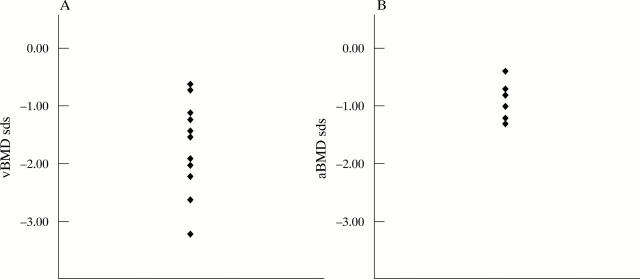Abstract
Background: Diminished bone mineral density (BMD) is a well known complication in women with classic galactosaemia caused by premature ovarian failure. Diminished BMD in prepubertal patients of either sex has, however, only been reported once.
Aim: To assess BMD in children with classic galactosaemia.
Methods: Eleven treated patients (five males, six females, aged 2–18 years) had BMD determined by dual energy x ray absorptiometry. Two measurements were performed, an areal measurement of the total body and a volumetric measurement of the femoral neck. Results were expressed as Z scores. Dietary calcium intake, blood calcium, phosphate, vitamin D, parathormone, and markers of bone formation (bone alkaline phosphatase, osteocalcin) and bone resorption (NTX) were determined.
Results: All patients had a significantly diminished BMD. Mean Z score of the volumetric BMD was -1.76 (range -0.7 to -3.3), and of the areal BMD -0.99 (range -0.5 to -1.4). Dietary calcium intake and calcium, phosphate, parathormone, bone alkaline phosphatase, vitamin D metabolites, and osteocalcin (free and carboxylated) were normal in all patients. NTX levels in blood were significantly lower (p < 0.001) than in control subjects.
Conclusion: BMD in this group of children of both sexes with classic galactosaemia under dietary treatment was decreased. Lower NTX levels in galactosaemics point to an apparent decreased bone resorption.
Full Text
The Full Text of this article is available as a PDF (85.2 KB).
Figure 1 .
Results of BMD measurements in study group, expressed in Z scores. (A) BMD of the femoral neck. (B) BMD of the total body.
Selected References
These references are in PubMed. This may not be the complete list of references from this article.
- Binkley N. C., Suttie J. W. Vitamin K nutrition and osteoporosis. J Nutr. 1995 Jul;125(7):1812–1821. doi: 10.1093/jn/125.7.1812. [DOI] [PubMed] [Google Scholar]
- Cowell C. T., Lu P. W., Lloyd-Jones S. A., Briody J. N., Allen J. R., Humphries I. R., Reed E., Knight J., Howman-Giles R., Gaskin K. Volumetric bone mineral density--a potential role in paediatrics. Acta Paediatr Suppl. 1995 Sep;411:12-6, discussion 17. doi: 10.1111/j.1651-2227.1995.tb13852.x. [DOI] [PubMed] [Google Scholar]
- Kaufman F. R., Loro M. L., Azen C., Wenz E., Gilsanz V. Effect of hypogonadism and deficient calcium intake on bone density in patients with galactosemia. J Pediatr. 1993 Sep;123(3):365–370. doi: 10.1016/s0022-3476(05)81733-0. [DOI] [PubMed] [Google Scholar]
- Lu P. W., Cowell C. T., LLoyd-Jones S. A., Briody J. N., Howman-Giles R. Volumetric bone mineral density in normal subjects, aged 5-27 years. J Clin Endocrinol Metab. 1996 Apr;81(4):1586–1590. doi: 10.1210/jcem.81.4.8636372. [DOI] [PubMed] [Google Scholar]
- Vermeer C. Gamma-carboxyglutamate-containing proteins and the vitamin K-dependent carboxylase. Biochem J. 1990 Mar 15;266(3):625–636. doi: 10.1042/bj2660625. [DOI] [PMC free article] [PubMed] [Google Scholar]
- Vermeer C., Jie K. S., Knapen M. H. Role of vitamin K in bone metabolism. Annu Rev Nutr. 1995;15:1–22. doi: 10.1146/annurev.nu.15.070195.000245. [DOI] [PubMed] [Google Scholar]



